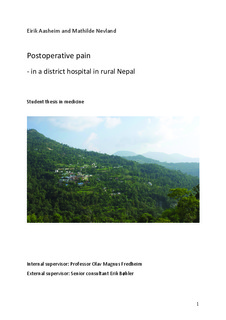| dc.description.abstract | Background: Postoperative pain management is essential for the patient's well-being and promotes early mobilization, shortens the hospital stay and prevents postoperative complications. Data from both Western countries and the developing world have shown that a significant number of patients suffer from moderate to severe postoperative pain. However, the conditions in rural hospitals are largely unreported. Based on data from other hospitals it is reasonable to believe that a significant number of patients in Okhaldhunga Hospital do not receive sufficient pain relief. Our aim with this study was to make a survey of the patients’ pain intensity and the prescription of analgesics the first postoperative day, and to discover important obstacles to satisfactory pain relief in Okhaldhunga Hospital. Material and method: A cross sectional prevalence survey was conducted among 55 inpatients from 5-61 years of age in Okhaldhunga Hospital. The study is based on three sources of information: The patients' self report the first postoperative day, the patient journal and chart, and the surgeon. Results: The mean pain intensity at the time of questioning the first postoperative day was 2,1 (SD 1,6) based on an 11-point numeric rating scale (NRS) and Wong Baker Faces Pain Rating Scale (WBFPRS). 16,4 % reported a pain intensity ≥ 4. For 11,1 % even the weakest pain at rest since surgery had been ≥ 4 (NRS), while for 63,2 % the strongest pain during movement had been ≥ 6 (NRS and WBFPRS). Multimodal pain treatment was prescribed regularly for 80,0 % of the patients. The prescribed regular analgesics were paracetamol (92,7 %), NSAIDs (74,5 %) and morphine (54,5 %). There was no documentation of pain intensity in the journal/chart, and only 5,3 % had been asked to grade their pain on a scale. 36,8% had been asked if they needed additional analgesics, while 60,5 % would say yes to more analgesics if it was offered to them. Conclusion: Despite extensive use of multimodal analgesia, 16,4 % reported moderate to strong pain the first postoperative day defined as ≥ 4 on an 11-point NRS, and 63,9 % had experienced a pain intensity ≥ 6. Areas of potential improvement are to ask the patients if they need more analgesics, using glucocorticoids as part of multimodal analgesia and documenting pain in patient charts. | nb_NO |
